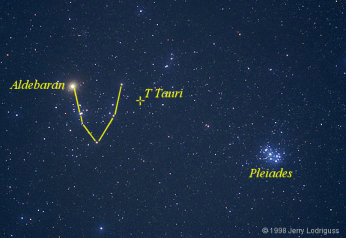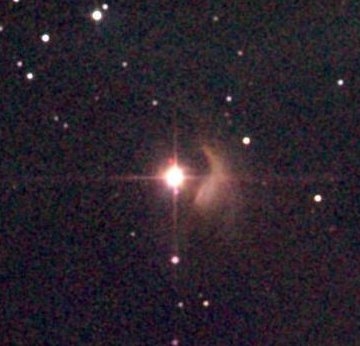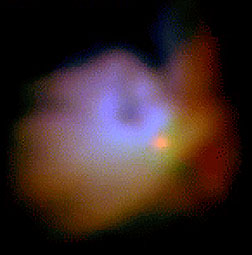T Tauri

Figure 1. Location of T Tauri in the sky. Credit Jerry Lodriguss:

Figure 2. T Tauri with Hind's Variable Nebula to the right. Image credit: Two Micron All Sky Survey.

Figure 3. A T Tauri star embedded within nebulosity.
T Tauri is the type T Tauri star. It was discovered in October 1852 by John Hind and lies approximately 460 light-years (140 parsecs) from the Sun in the constellation Taurus (Figure 1).
Like all members of its kind, T Tauri is an irregular variable. It has been known to shine as brightly as magnitude 9.3 and as dimly as magnitude 14, though for the past century or so it has tended toward the brighter end of this range. It can vary by a few tenths of a magnitude on nearly a daily basis without any discernible pattern.
Hind's Variable Nebula
Not far from T Tauri, Hind found a reflection nebula, now called Hind's Variable Nebula (Figure 2), which is illuminated at the whim of its unreliable neighbor. Hind's Variable Nebula is remarkable for its changes in brightness, which are due to wide variations in T Tauri itself. Discovered by Hind in 1852, it began to fade after 1861 and had disappeared from view to even the largest telescopes of the time by 1868. It was not seen again until 1890 when it was observed by Edward Barnard and Sherburne Burnham. Since the 1930s it has been gradually brightening but remains a challenge for the amateur observer.
Burnham's Nebula
In 1890, nearly 40 years after the discovery of T Tauri, Shelburn Burnham found that T Tauri is nestled within a much smaller nebula, now popularly known as Burnham's Nebula. When Burnham made his discovery, T Tauri was shining feebly at 14th magnitude – at the limit of most telescopes of the time. The condensed nebula appeared to be about arc-seconds in size in its longest dimension. T Tauri has been brighter than 10th magnitude since the early 20th century making this feature very hard to detect. Burnham's Nebula can be discerned in an overexposed image of T Tauri as a bulge extending about 10 arcseconds from the star. Unlike Hind's Variable Nebula, it is not believed to be a reflection nebula.
Other components of the T Tauri system
Much more recently, 30 arcsec west of the brightest point in Hind's nebula has been uncovered a Herbig-Haro object – a jet of the type commonly associated with young, mass-ejecting stars. As if all this were not enough, T Tauri turns out to have a binary companion, detected by its infrared glow, 0.5 arcsecond to the south – hence known as T Tauri S, while T Tauri becomes T Tauri N – and there is even data to such that T Tauri is a triple-star system.
T Tauri stars
A T Tauri star is a very young, lightweight star, less than 10 million years old and under 3 solar masses, that it still undergoing gravitational contraction. It represents an intermediate stage between a protostar and a low-mass main sequence star like the Sun (Figure 3).
T Tauri stars are found only in nebulae or very young clusters, have low-temperature (G to M type) spectra with strong emission lines and broad absorption lines. They are more luminous than main sequence stars of similar spectral types, and they have a high lithium abundance, which is a pointer to their extreme youth, as lithium is rapidly destroyed in stellar interiors.
T Tauri stars often have large accretion disks left over from stellar formation. Their erratic brightness changes may be due to instabilities in the disk, violent activity in the stellar atmosphere, or nearby clouds of gas and dust that sometimes obscure the starlight.
Two broad T Tauri types are recognized based on spectroscopic characteristics that arise from their disk properties: classic T Tauri and weak-lined T Tauri stars. Classical T Tauri stars have extensive disks that result in strong emission lines. Weak-lined T Tauri stars are surrounded by a disk that is very weak or no longer in existence. The weak T Tauri stars are of particular interest since they provide astronomers with a look at early stages of stellar evolution unencumbered by nebulous material. Some of the absent disk matter may gone into making planetesimals, from which planets might eventually form. According to one estimate, about 60% of T Tauri stars younger than 3 million years may possess dust disks, compared with only 10% of stars that are 10 million years old. Infant star relatives of T Tauris include FU Orionis stars and YY Orionis stars.
The nearest T Tauri stars occur in the Taurus molecular cloud and the rho Ophiuchus Cloud, both about 460 light-years (140 pc) away. They are named after the prototype T Tauri.
T association
A T association is a grouping of T Tauri stars, up to several thousand strong, typically embedded in and partly obscured by the nebula from which it formed. It is one of the main types of stellar association. Examples include the Taurus-Auriga T Association, the nearby TW Hydrae Association, and Vela T1 and T2. Additionally, many T Tauri stars are found in other groupings not named as T associations; for example, at least 2,000 T Tauris are believed to exist in the Scorpius-Centaurus OB Association and a handful in the young open cluster Collinder 197. T associations gradually break up after 10 million years or so as the component stars go their separate ways. The recently-found and nearby Horologium Association, lying about 200 light-years away and believed to be about 10 million years old, contains at least 10 young stars of which half a dozen are characterized as post-T Tauri.
YY Orionis star
A YY Orionis star is an extremely young star, preceding even the T Tauri stage. YY Orionis stars are very young, late-type, low-mass stars, still contracting gravitationally and accreting matter from the protostellar cloud. They show inverse P Cygni profiles corresponding to an infall of material at 300–400 kilometers per second directly onto the star.


